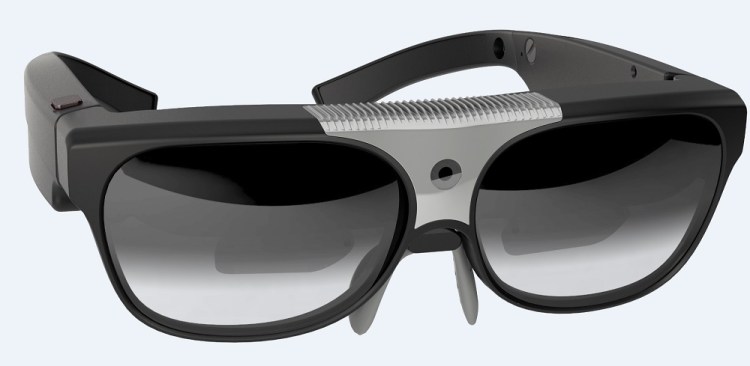Move over, Google Glass.
Osterhout Design Group is unveiling a consumer prototype of its augmented-reality smartglasses today as it aims to transfer an expensive technology developed for the military into the consumer wearables market.
The San Francisco company spent six years and $60 million refining its military technology for the consumer market, and it’s finally ready to show off a consumer prototype of its smartglasses at next week’s 2015 International CES tech trade show in Las Vegas. The device packs a lot of tech, and ODG execs hope it will be perceived as a next-generation product. ODG will have lots of competition at CES, and its challenge will be in making a $5,000 technology available for under $1,000.
The glasses weigh just five ounces and look like a pair of heavy sunglasses. I had a good look at them under ideal conditions at ODG’s offices in San Francisco, and it was a cool experience. You can see the world around you through the transparent lenses, but you can also view images on the surface of the inside of the glasses as if you were viewing a 720p high-definition TV. ODG has been shipping its R-6 smartglasses for 18 months, it is showing off the R-6S next week, and it hasn’t yet named the consumer prototype coming this year.
The ultimate test will depend on whether Android application developers take advantage of its capabilities in hands-free augmented reality, high-definition video viewing, and 3D entertainment.
Pete Jameson, chief operating officer of the firm started by famous product designer Ralph Osterhout, told VentureBeat that head-worn computing devices and augmented reality are ripe for the consumer market after many years of experimentation.
“We have been refining the platform and the visual experience,” he said. “You can wear it sitting or reclining or walking down the street.”
Jameson showed off applications that you can’t do on a laptop, phone, or tablet. You can, for instance view things that no one else can see, so you can work privately on an airplane or train without fear that someone next to you is looking at your screen. You can watch 3D movies on a large screen in bright sunlight, play interactive 3D games that mesh with your surroundings, or get line-of-sight directions or instructions while keeping your hands free and your eyes engaged with your surroundings.
ODG has loaded the device with its proprietary optical and electronic configurations that enable a sleeker, lighter style. But the R-6S contains the same tech as the company’s previous glasses for government and enterprise applications. ODG expects to debut its first consumer product on the new platform under a new name this year for under $1,000.
ODG has developed a new version of its glasses every year for the past six years. Ralph Osterhout was the designer of the PVS-7 Night Vision Goggles for the military, and he also created heads-up displays in scuba masks. He was passionate about wearable tech long before it became fashionable.
“Our R-6 Smart Glasses are proving their worth in some of the world’s toughest environments, and we look forward to bringing our innovative technology closer to everyday consumers,” said Ralph Osterhout, CEO and founder of ODG, in a statement. “At ODG, we’re working to change the world of computing by the way we interact, connect, and explore information, and I am happy to introduce the next step on this journey and to be heading to CES to showcase our smartglasses system.”
ODG’s smartglasses have positional sensors, so the glasses know where you are, where you’re looking, and how you’re moving. That enables much more precise augmented reality and virtual reality experiences. The device has a quad-core Qualcomm Snapdragon processor with 802.11ac Wi-Fi wireless networking and navigation via the global positioning system (GPS), Russian Glonass, and Magellan satellite networks. It has 128-gigabytes of storage, magnetic audio jacks, two digital microphones, a 5-megapixel camera, and hardened tech for rugged environments.
The device works with face-detection applications, and it has dual independently driven displays. A $5,000 version has been shipping to government customers for more than a year, said Nima Shams, .
Shams said that the costs have been driven down over time, and the glasses are light enough at 125 grams so that people can wear them for hours at a time. The nose pads are adjustable and replaceable, and you can snap in corrective lenses if needed. It also has Bluetooth low-energy connectivity.
You can control the device with gestures such as tapping twice on the side of the frames. You can also control what you see on the screen via a touchscreen app that runs on your Android or iOS smartphone.
Qualcomm has tools for creating augmented-reality apps that can run on the R-6S and future versions.
ODG was founded in 1999 as a tech incubator, and now it is focused on making wearable-based security and first-responder solutions for government, enterprise and ultimately, consumer markets. It has 80 employees.
VentureBeat's mission is to be a digital town square for technical decision-makers to gain knowledge about transformative enterprise technology and transact. Learn More





